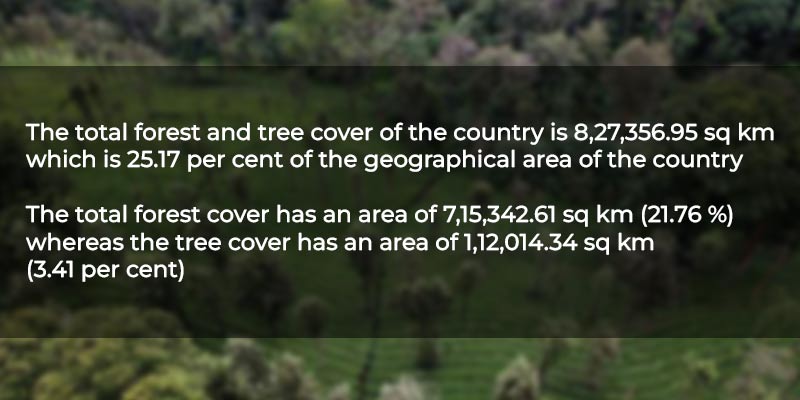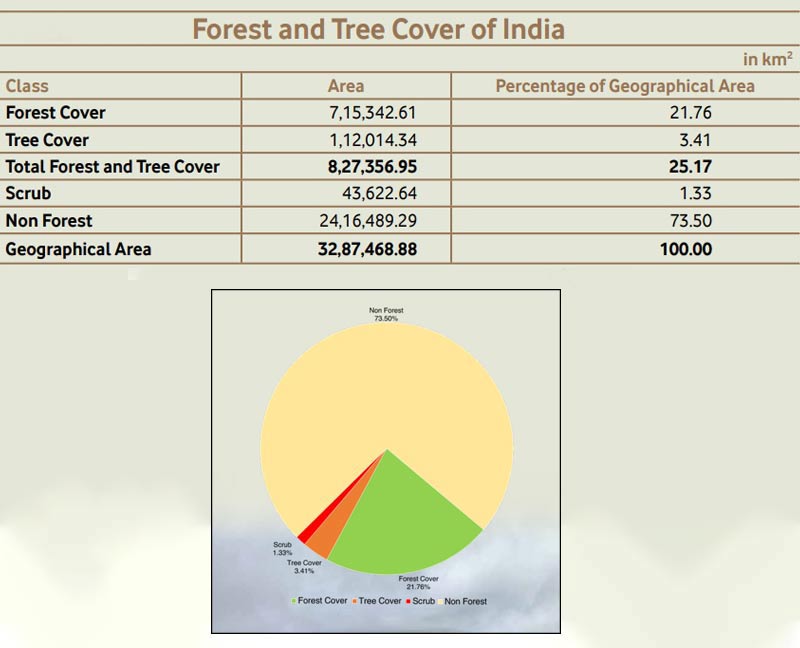- India
- Dec 23
India’s forest and tree cover grows by 1,445 sq km
• Minister for Environment, Forest and Climate Change, Bhupender Yadav released the ‘India State of Forest Report 2023’ (ISFR 2023).
• India’s total forest and tree cover rose by 1,445 square kilometres since 2021, reaching 25.17 per cent of the total geographical area in 2023, revealed the report.
• The forest cover grew by 156 square kilometres, while tree cover expanded by 1,289 square kilometres.
• Most of the gain in forest cover occurred outside the Recorded Forest Area (RFA), which refers to areas designated as forests in government records.
Preparation of the report
• The National Forest Policy (1988) sets a vision of having a minimum of one-third of the total land area of the country under forest or tree cover.
• The policy further envisions that in the hills and in mountainous regions, the aim should be to maintain two-thirds of the area under such cover in order to prevent erosion.
• Forest cover refers to all land that has a tree canopy density of more than 10 per cent and spans over an area of one hectare or more, regardless of the type of ownership or legal status. This includes natural forests as well as man-made plantations, orchards and tree patches in urban and rural areas that meet the size and canopy density criteria.It may be located within recorded forests, or on other government, private, or institutional lands.
• Tree cover comprises all tree patches outside the forest area, which are less than one hectare in extent including all the scattered trees found in the rural and urban settings, and not captured under the forest cover assessment.
• Since 1987, Forest Survey of India (FSI) has been conducting biennial assessments of India’s forest cover through remotely sensed data.
• The Forest Survey of India, an organisation under the Ministry of Environment, Forest and Climate Change, has been mandated to carry out a regular assessment of forest resources of the country using satellite data and field based information.
• The tree cover has been assessed by FSI since the year 2001. The outcomes of these assessments are meticulously recorded in the India State of Forest Reports (ISFRs) released biennially.
• As of now, 17 cycles of Forest Cover Mapping (FCM) have been executed with proficiency, and the current ISFR marks the 18th edition within this ongoing series. For tree cover, this is the 11th assessment.
• These periodic assessments of forest cover and tree cover offer a comprehensive view of the state of India’s forests and trees outside the forests; and, their overarching trends over the years. This report serves as a crucial and widely recognised source of information for forestry experts across various domains.
• For ISFR-2023, the government included bamboo and trees with a diameter of 5-10 centimetres at breast height in the tree cover estimates. It expanded the assessment to 751 districts compared to 636 in 2021.
Key points of the report:
• The total forest and tree cover of the country is 8,27,356.95 sq km which is 25.17 per cent of the geographical area of the country.
• The total forest cover has an area of 7,15,342.61 sq km (21.76 per cent) whereas the tree cover has an area of 1,12,014.34 sq km (3.41 per cent).
• India achieved an additional carbon sink of 2.29 billion tonnes compared to 2005 levels.
• As part of its climate plans or Nationally Determined Contributions (NDCs) to meet the Paris Agreement goals, the country has committed to creating an additional carbon sink of 2.5 to 3 billion tonnes through additional forest and tree cover by 2030.
• India experienced degradation of around 93,000 square kilometres of forests between 2011 and 2021.
• Around 636.5 million tonnes of carbon can be sequestered through density upgradation in degraded areas.
• Chhattisgarh recorded the highest increase in forest and tree cover, with a gain of 683.62 sq km, followed by Uttar Pradesh (559.19 sq km), Odisha (558.57 sq km) and Rajasthan (394.46 sq km).
• The largest declines were observed in Madhya Pradesh (612.41 sq km), Karnataka (459.36 sq km), Ladakh (159.26 sq km) and Nagaland (125.22 sq km).
• Within the RFA, Mizoram showed the largest increase in forest cover, adding 192.92 sq km, followed by Odisha (118.17 sq km), Karnataka (93.14 sq km), West Bengal (64.79 sq km) and Jharkhand (52.72 sq km).
• The steepest declines in forest cover inside RFA were recorded in Tripura (116.90 sq km), Telangana (105.87 sq km), Assam (86.66 sq km), Andhra Pradesh (83.47 sq km) and Gujarat (61.22 sq km).
• Outside RFA, Gujarat saw the highest increase in forest cover, with a gain of 241.29 sq km, followed by Bihar (106.85 sq km), Kerala (95.19 sq km), Uttar Pradesh (79.27 sq km), and Assam (74.90 sq km).
• The most significant losses outside RFA occurred in Madhya Pradesh (344.77 sq km), Rajasthan (110.65 sq km), Andhra Pradesh (55.19 sq km), Arunachal Pradesh (45.32 sq km) and Maharashtra (41.07 sq km).
• The FSI analysed forest cover changes in the ecologically fragile Western Ghats over the past decade and found an overall loss of 58.22 sq km.
• In the region, the Nilgiris reported the steepest decline of 123 sq km. The mountain range, spread across Karnataka, Kerala and Tamil Nadu, is known for its popular tourist spots.
• The latest assessment shows an increase of 234.14 sq km in forest cover in the hill districts.
• The report showed a decrease of 327.30 sq km in forest cover in the northeastern region.
• India’s total bamboo-bearing area is now estimated at 1.54 lakh sq km, an increase of 5,227 square kilometres from 2021.
• The country’s total mangrove cover stands at 4,991.68 sq km, a net decrease of 7.43 sq km since 2021.
• Moderately dense forest and open forest categories saw declines of 1,043.23 sq km and 2,480.11 sq km, respectively, over the past decade, despite gains in very dense forest.
• More than 40,709 sq km of very dense forest and moderately dense forest within RFA degraded to open forest between 2011 and 2021.
• The government also reported the degradation of 5,573 sq km of very dense forest, moderately dense forest, and open forest to scrub during this period. A total of 46,707 sq km of very dense forest, moderately dense forest, open forest, and scrub degraded to non-forest.
Manorama Yearbook app is now available on Google Play Store and iOS App Store


